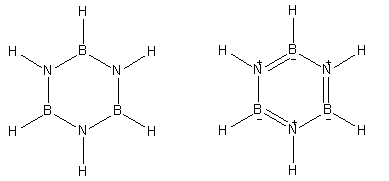
Inorganic benzene is:
(A) \[{B_3}{N_6}{H_3}\]
(B) \[{B_3}{N_3}{H_6}\]
(C) \[A{l_3}{N_3}{H_6}\]
(D) None of these
Answer
224.7k+ views
Hint: The chemical name of inorganic benzene is borazine. It is a cyclic structure involving two atoms of p-block elements. It has similar chemical reactivity as benzene.
Complete step by step solution:
Here is the structure of Borazine which is known as inorganic benzene.

Both of the structures shown here are of borazine. It has boron, nitrogen and hydrogen atoms in its constitution.
- Borazine is known as inorganic benzene because it is made up of inorganic atoms and has similar reactivity as organic compound benzene. In its neutral structure, borazine has six hydrogen atoms directly bonded to the three nitrogen and three boron atoms.
- Borazine gives a secondary structure that involves three double bonds in the ring and positive and negative charges on nitrogen and boron atoms respectively.
- Borazine can give additional reactions as benzene can give. In fact some reactions like addition of bromine to the ring can be done without the requirement of a catalyst.
- Borazine also follows the Huckel rule, hence it is also aromatic, however it has some difference in comparison with benzene because it involves two atoms with different electronegativity.
- It does not involve Aluminium in its structure. It just has boron and nitrogen atoms arranges alternatively in the ring. So,its chemical formula is \[{{B}_{3}}{{N}_{3}}{{H}_{6}}\].
Note: Do not consider that inorganic benzene has three hydrogen atoms as it will not fulfil the valency of the atoms. Make sure that the structure that you think of borazine should be able to give chemical reactions like benzene, the only structure possible is the answer.
Complete step by step solution:
Here is the structure of Borazine which is known as inorganic benzene.

Both of the structures shown here are of borazine. It has boron, nitrogen and hydrogen atoms in its constitution.
- Borazine is known as inorganic benzene because it is made up of inorganic atoms and has similar reactivity as organic compound benzene. In its neutral structure, borazine has six hydrogen atoms directly bonded to the three nitrogen and three boron atoms.
- Borazine gives a secondary structure that involves three double bonds in the ring and positive and negative charges on nitrogen and boron atoms respectively.
- Borazine can give additional reactions as benzene can give. In fact some reactions like addition of bromine to the ring can be done without the requirement of a catalyst.
- Borazine also follows the Huckel rule, hence it is also aromatic, however it has some difference in comparison with benzene because it involves two atoms with different electronegativity.
- It does not involve Aluminium in its structure. It just has boron and nitrogen atoms arranges alternatively in the ring. So,its chemical formula is \[{{B}_{3}}{{N}_{3}}{{H}_{6}}\].
Note: Do not consider that inorganic benzene has three hydrogen atoms as it will not fulfil the valency of the atoms. Make sure that the structure that you think of borazine should be able to give chemical reactions like benzene, the only structure possible is the answer.
Recently Updated Pages
JEE Main 2026 Session 1 Correction Window Started: Check Dates, Edit Link & Fees

JEE Isolation, Preparation and Properties of Non-metals Important Concepts and Tips for Exam Preparation

Isoelectronic Definition in Chemistry: Meaning, Examples & Trends

Ionisation Energy and Ionisation Potential Explained

Iodoform Reactions - Important Concepts and Tips for JEE

Introduction to Dimensions: Understanding the Basics

Trending doubts
JEE Main 2026: City Intimation Slip and Exam Dates Released, Application Form Closed, Syllabus & Eligibility

JEE Main 2026 Application Login: Direct Link, Registration, Form Fill, and Steps

Understanding the Angle of Deviation in a Prism

How to Convert a Galvanometer into an Ammeter or Voltmeter

Hybridisation in Chemistry – Concept, Types & Applications

Ideal and Non-Ideal Solutions Explained for Class 12 Chemistry

Other Pages
JEE Advanced Marks vs Ranks 2025: Understanding Category-wise Qualifying Marks and Previous Year Cut-offs

Thermodynamics Class 11 Chemistry Chapter 5 CBSE Notes - 2025-26

Organic Chemistry Some Basic Principles And Techniques Class 11 Chemistry Chapter 8 CBSE Notes - 2025-26

JEE Advanced 2026 - Exam Date (Released), Syllabus, Registration, Eligibility, Preparation, and More

JEE Advanced 2026 - Exam Date (Released), Syllabus, Registration, Eligibility, Preparation, and More

Hydrocarbons Class 11 Chemistry Chapter 9 CBSE Notes - 2025-26




